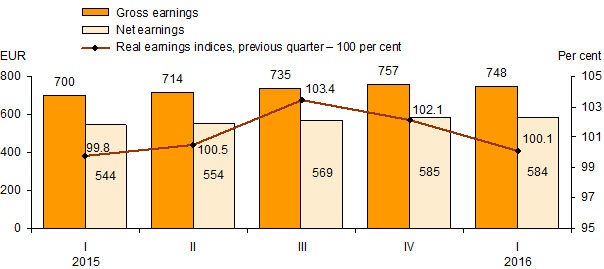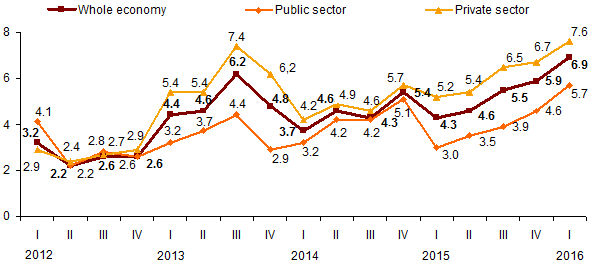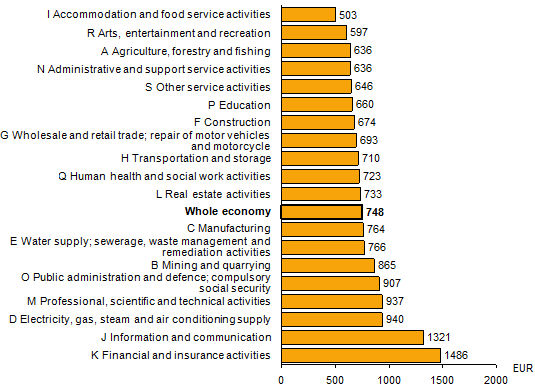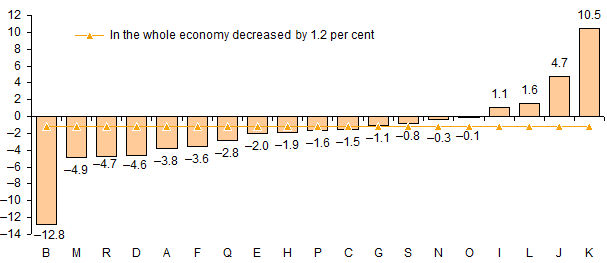Analytics, Economics, Financial Services, Lithuania, Markets and Companies, Wages
International Internet Magazine. Baltic States news & analytics
Saturday, 27.04.2024, 02:11
In Q1, gross earnings in the whole economy in Lithuania decreased by 1.2%
 Print version
Print version
Average net monthly earnings in the whole economy amounted to EUR 583.9, and against IV quarter 2015, decreased by 0.2%: in the public sector – EUR 594.4 (decreased by 1.5%), in the private sector – EUR 578.5 (increased by 0.6%).
In I quarter 2016, against IV quarter 2015, real earnings in the whole economy grew by 0.1%: in the public sector – decreased by 1.2%, in the private sector – increased by 0.9%.
In I quarter 2016, against IV quarter 2015, the decrease in earnings was determined by reduced number of working days, seasonal fluctuations, lower irregular premiums, bonuses, lump sum benefits and other reasons.
 |
| Fig. 1. Average monthly earnings in the whole economy (1), by quarters |
Over the year, gross earnings in the whole economy grew by 6.9%
In I quarter 2016, against I quarter 2015, average gross monthly earnings in the whole economy1 increased by 6.9%: in the public sector –5.7%, in the private sector – 7.6%.
Over the year, average net monthly earnings in the whole economy increased by 7.4%: in the public sector – 6.3%, in the private sector – 8.1%.
Over the year, real earnings in the whole economy increased by 6.3%: in the public sector – 5.2%, in the private sector – 7%.
Over the said period, the increase in earnings was influenced by the increased volume of work and number of working hours, increased minimum monthly wage (since 1 January 2016, EUR 350) and other reasons. More rapid increase in net earnings, as compared to gross earnings, was influenced by the change in the procedure for the calculation of the tax-exempt amount of income and increased additional tax-exempt amount of income set in the Law on Income Tax of Individuals of the Republic of Lithuania from 1 January 2016.
________________________
1 Less individual enterprises
2 Public sector covers budgetary institutions and organisations
(educational, health care, social work, cultural, public administration, etc.),
public establishments, enterprises where state and municipal property makes up
50% or more of authorised capital.
 |
| Fig. 2. Change in average gross monthly earnings1 by sectors, compared with the respective quarter of the previous year, % |
In I quarter 2016, a decrease in gross earnings was observed in most economic activities
In I quarter 2016, against IV quarter 2015, average gross monthly earnings in the whole economy[1] decreased in most economic activities: from 12.8% (mining and quarrying) to 0.1% (public administration and defence; compulsory social security). An increase in average gross monthly earnings was observed in four economic activities: accommodation and food service activities – 1.1, real estate activities – 1.6, information and communication – 4.7, financial and insurance activities – 10.5%.
Over the year, average gross monthly earnings in the whole economy grew in all economic activities.
 |
| Fig. 3. Average gross monthly earnings (1) by economic activity, I quarter 2016 |
1 Less individual enterprises
 |
| Fig. 4. Change in average gross monthly earnings1 by economic activity, I quarter 2016, compared to the previous quarter, % |
Compared to the respective quarter of 2015

A – Agriculture, forestry and
fishing
B – Mining and quarrying
C – Manufacturing
D – Electricity, gas, steam and air conditioning supply
E – Water supply; sewerage, waste management and remediation activities
F – Construction
G – Wholesale and retail trade; repair of motor vehicles and motorcycle
H – Transportation and storage
I – Accommodation and food service activities
J – Information and communication
K – Financial and insurance activities
L – Real estate activities
M – Professional, scientific and technical activities
N – Administrative and support service activities
O – Public administration and defence; compulsory social security
P – Education
Q – Human health and social work activities
R – Arts, entertainment and recreation
S – Other service activities
Table 1. Average monthly earnings (1) by sector and sex of employees, I quarter 2016, EUR
|
|
Gross |
Net |
||||
|
total |
males |
females |
total |
males |
females |
|
|
Whole economy |
748.0 |
811.2 |
687.7 |
583.9 |
628.7 |
541.1 |
|
Public sector |
762.8 |
864.4 |
708.8 |
594.4 |
666.4 |
556.1 |
|
Private sector |
740.4 |
794.2 |
671.6 |
578.5 |
616.6 |
529.7 |
________________________
1 Less individual enterprises
Table 2. Indices of average monthly earnings1 by sector and sex of employees, I quarter 2016
|
|
Previous quarter – 100% |
Respective quarter of the previous year – 100% |
||||
|
total |
males |
females |
total |
males |
females |
|
|
Gross |
|
|
|
|
|
|
|
Whole economy |
98.8 |
98.9 |
98.9 |
106.9 |
107.0 |
106.7 |
|
Public sector |
97.4 |
98.0 |
97.1 |
105.7 |
105.9 |
105.8 |
|
Private sector |
99.6 |
99.2 |
100.4 |
107.6 |
107.5 |
107.7 |
|
Net |
|
|
|
|
|
|
|
Whole economy |
99.8 |
99.7 |
100.1 |
107.4 |
107.4 |
107.4 |
|
Public sector |
98.5 |
98.7 |
98.4 |
106.3 |
106.2 |
106.5 |
|
Private sector |
100.6 |
100.0 |
101.7 |
108.1 |
107.9 |
108.4 |
|
Real |
|
|
|
|
|
|
|
Whole economy |
100.1 |
100.0 |
100.4 |
106.3 |
106.3 |
106.3 |
|
Public sector |
98.8 |
99.0 |
98.7 |
105.2 |
105.1 |
105.4 |
|
Private sector |
100.9 |
100.3 |
102.0 |
107.0 |
106.8 |
107.3 |
________________________
1 Less individual enterprises
In I quarter 2016, the average number of employees increased by 1.3%
In I quarter 2016, against IV quarter 2015, the average number of employees in the whole economy increased by 15.3 thousand (1.3%). It was conditioned by a 17.2 thousand (2.1%) increase in the average number of employees in the private sector. In the public sector, the average number of employees dropped by 1.9 thousand (0.5%).
Over the year, in I quarter 2016, against I quarter 2015, the average number of employees in the whole economy increased by 15.5 thousand (1.3%). It was conditioned by 19.1 thousand (2.4%) increase in the average number of employees in the private sector. In the public sector, the average number of employees over the year dropped by 3.6 thousand (0.9%).
Concepts
Gross earnings – remuneration in cash covering the basic wage and bonuses, payable by the employer to the employee directly, including social insurance contributions and individual income tax payable by the employee. Material and temporary unemployment benefits paid irrespective of the source of finance, compensation for unused annual leave, severance pays and similar benefits are excluded.
Net earnings – remuneration in cash covering the basic wage and bonuses, payable by the employer to the employee directly, excluding social insurance contributions and individual income tax payable by the employee.
Index of real earnings – a relative indicator reflecting the change in net earnings after the influence of the change in prices for consumer goods and services has been eliminated.
More information on the issue is available in the Database of Indicators of
Statistics Lithuania.








 «The Baltic Course» Is Sold and Stays in Business!
«The Baltic Course» Is Sold and Stays in Business!

